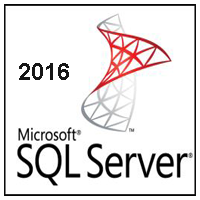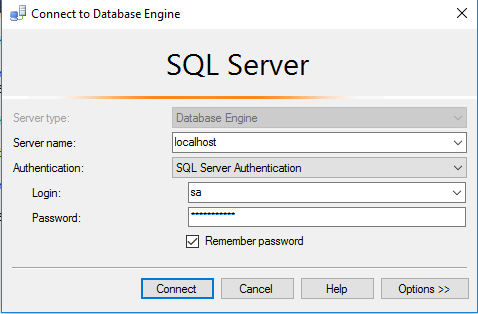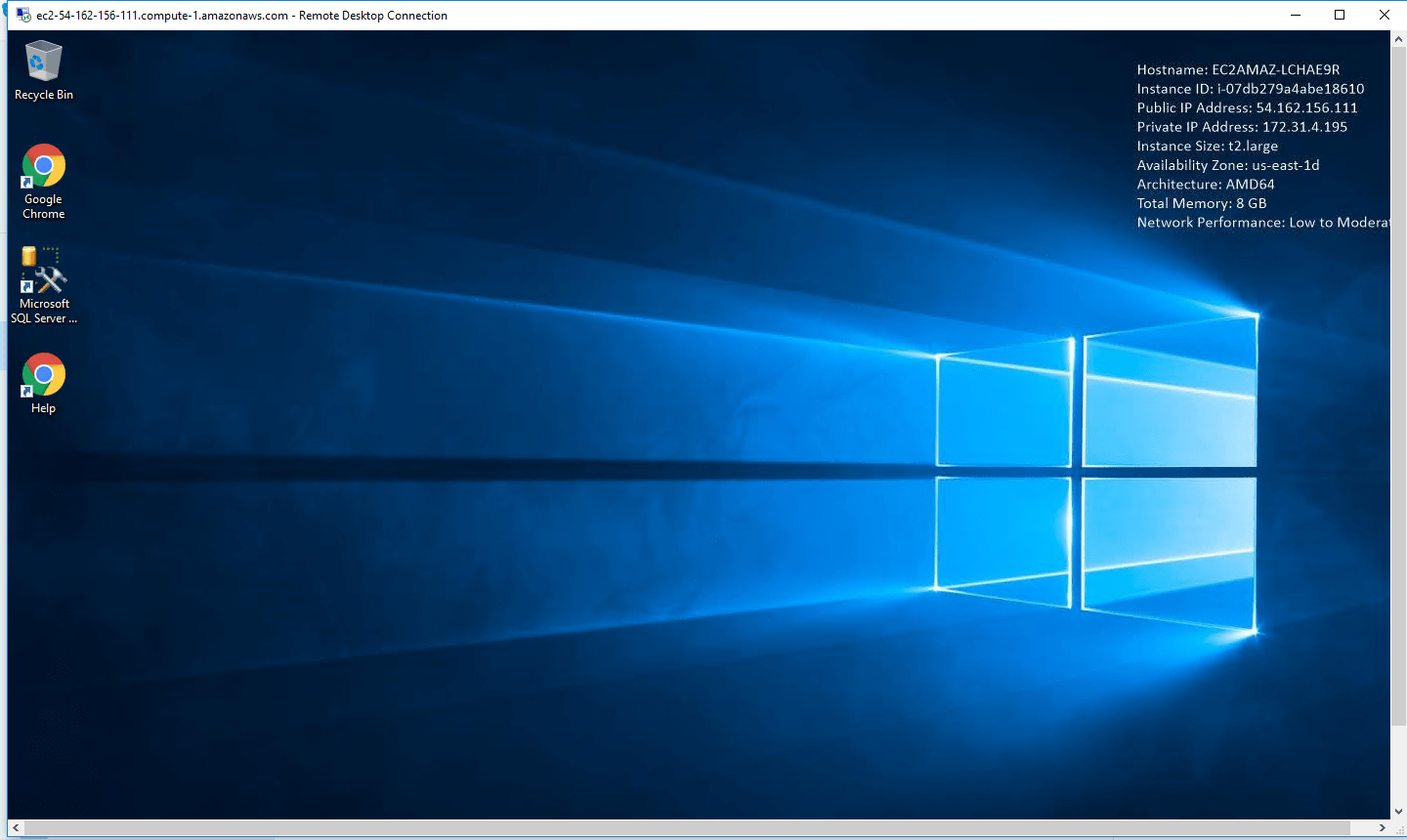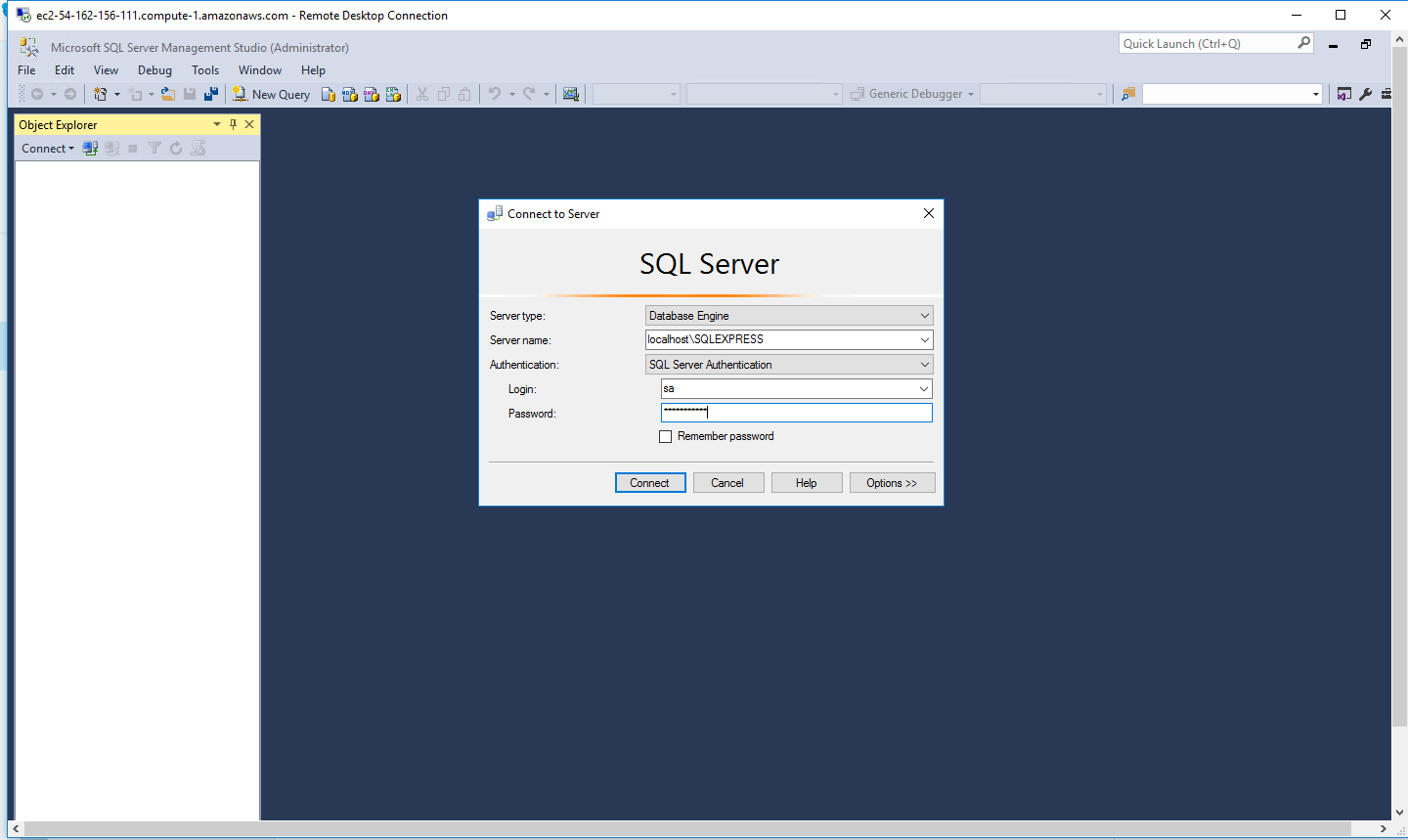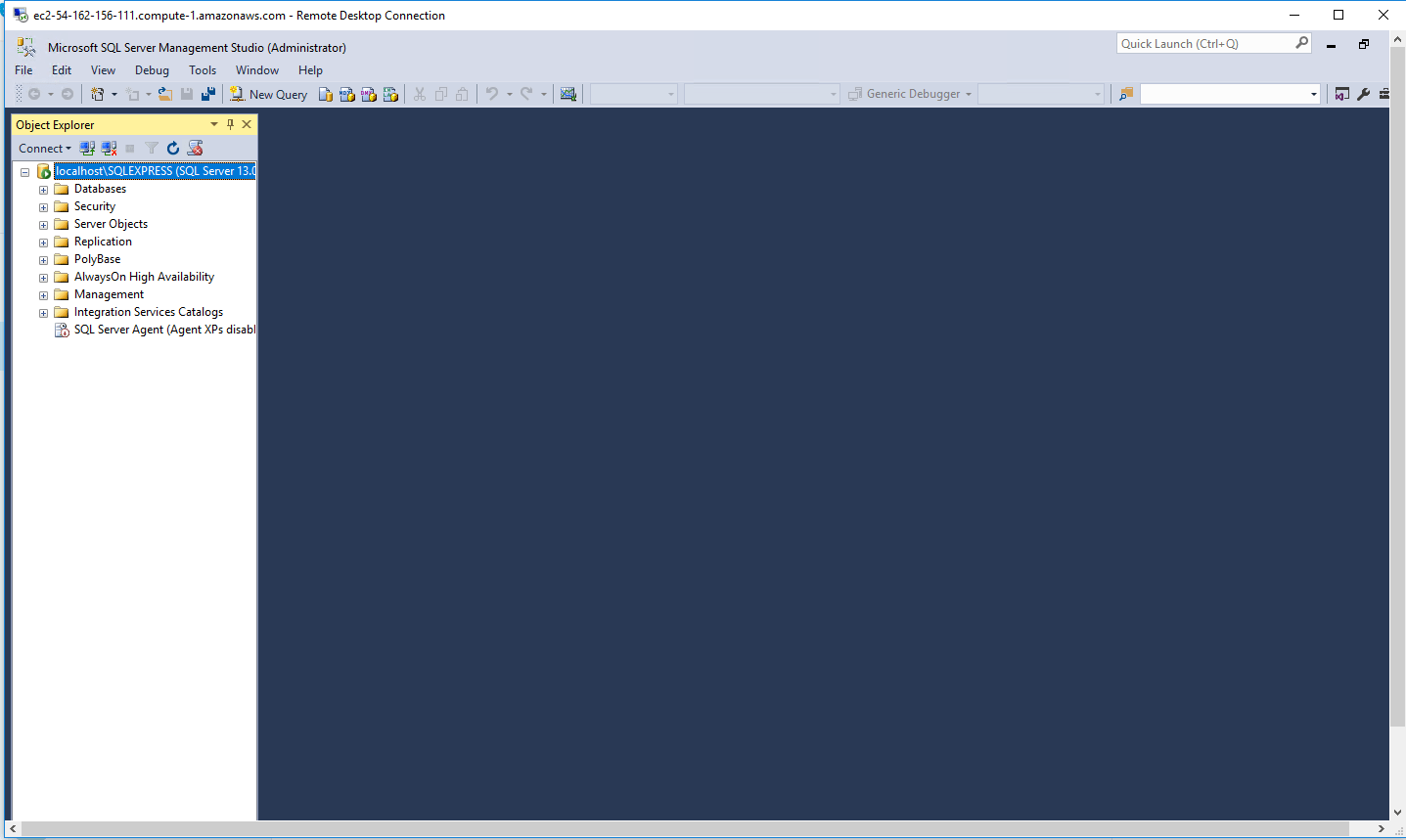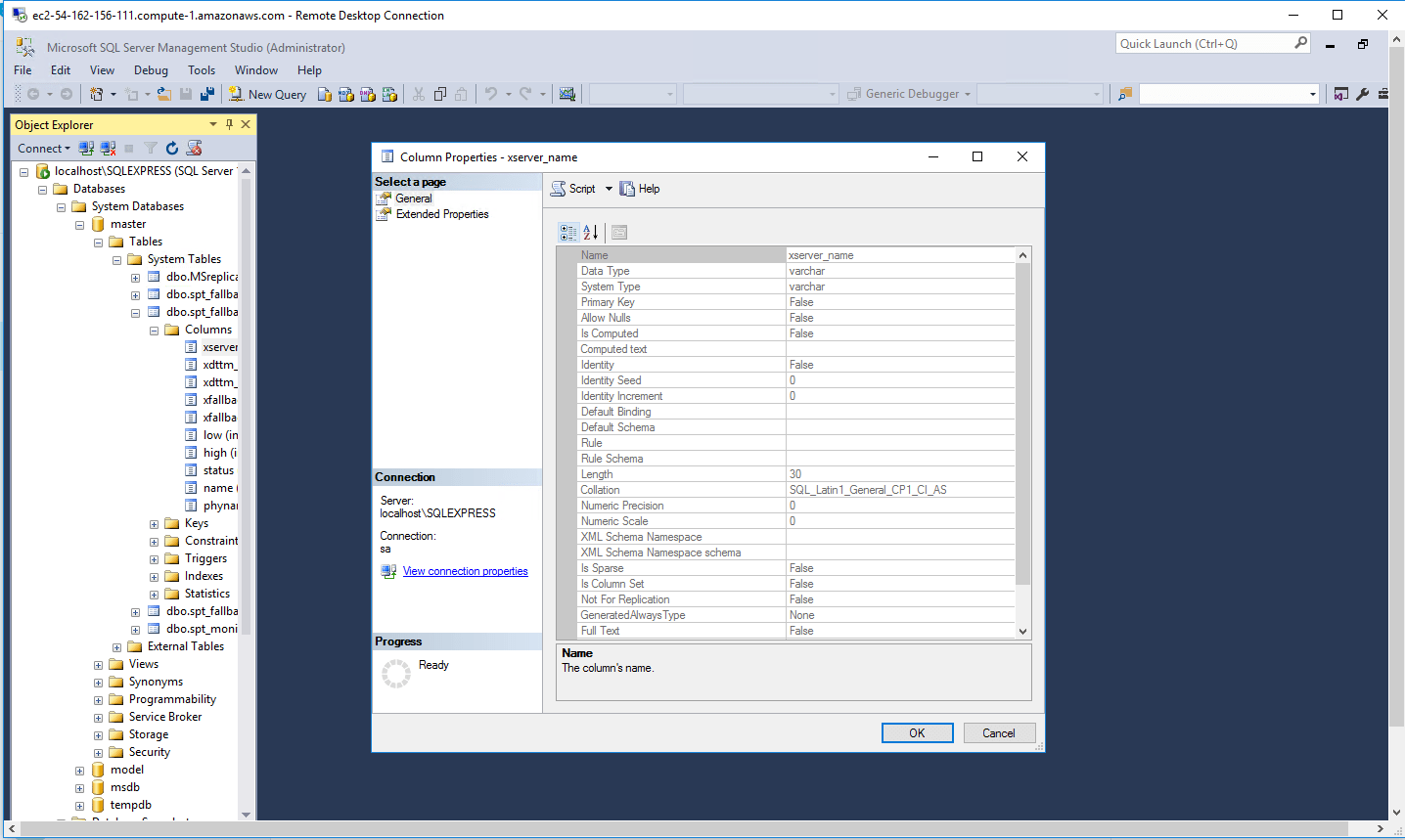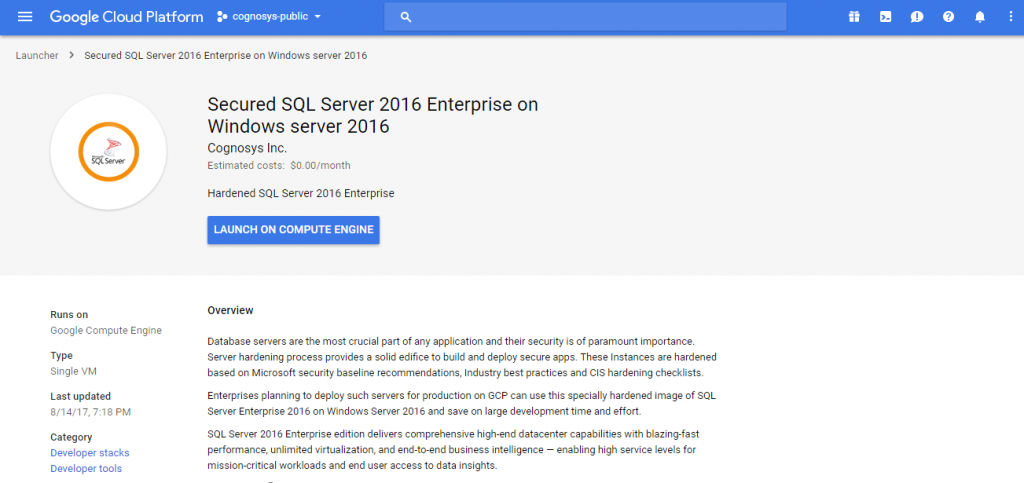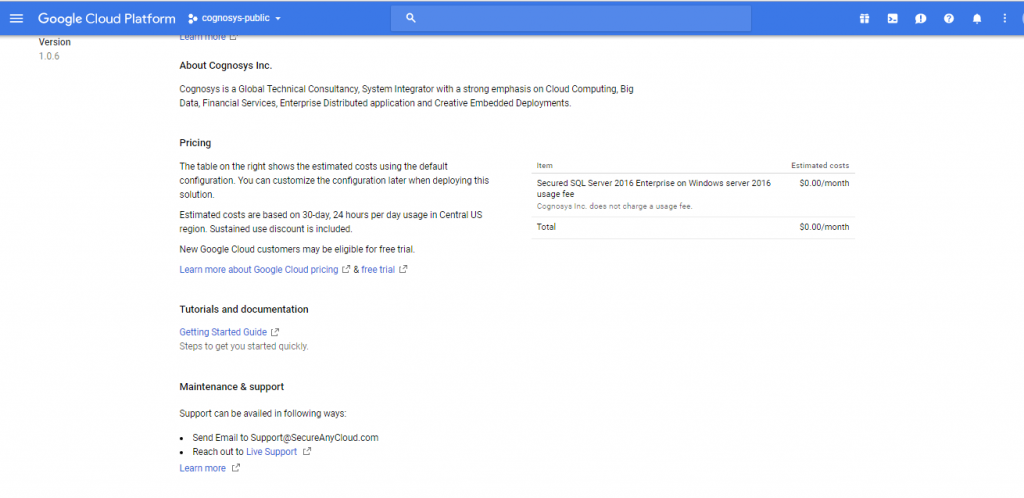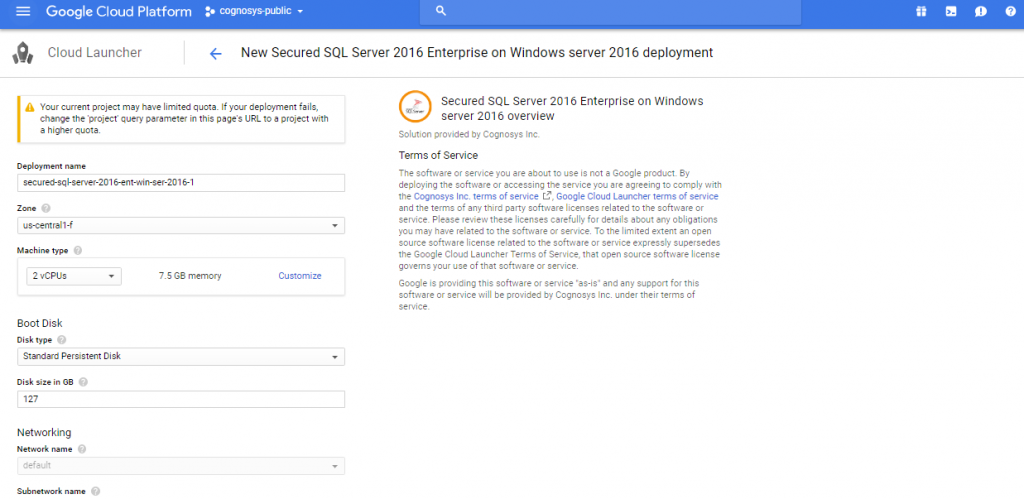1-click AWS Deployment 1-click Google Deployment
Overview
Overview of SQL Server Enterprise:
Microsoft SQL Server is an accessible, high-performance database management system. Designed to meet the requirements of distributed client-server computing, SQL Server enables organizations to improve decision-making and streamline business processes. Microsoft SQL Server is your solution to complex business problems. It offers reduced complexity for users, administrators and developers as well as quicker, easier-to-use business solutions at lower costs.Microsoft SQL Server Enterprise Edition is the complete database and analysis offering that rapidly delivers the next generation of scalable e-commerce, line-of-business and data warehousing solutions. It includes the complete set of SQL Server database and analysis features and is uniquely characterized by several features that make it the most scalable and available edition of SQL Server. It scales to the performance levels required to support the largest Web sites and enterprise online transaction processing (OLTP) and data warehousing systems. Its support for fail over clustering also makes it ideal for any mission critical line-of-business application.
Microsoft build SQL 2016 keeps a lot of things in mind like Cloud first, Security enhancement, JSON support, Temporal database support, Row level security, Windows server 2016 connectivity, Non-relational database connectivity (e.g. Hadoop), rich visual effects, etc. With SQL Server 2016, you can build intelligent, mission-critical applications using a scalable, hybrid database platform that has everything built in, from in-memory performance and advanced security to in-database analytics. The SQL Server 2016 release adds new security features, querying capabilities, Hadoop and cloud integration, R analytics and more, along with numerous improvements and enhancements.
Best among SQL Enterprise and SQL Standard :
The two SQL Server editions both have similar features for management tools, RDBMS Manageability, Development Tools, and Programmability. Despite many similarities between the two editions, it is clear that Enterprise delivers more functionality than the other editions of SQL Server, including the Standard edition. A company that has a need for all the additional features and scalability of Microsoft SQL Enterprise, should opt for this edition. Whereas, smaller organizations may be able to utilize the foundation offered by SQL Server Standard edition.
Microsoft SQL Enterprise
Microsoft SQL Server Enterprise includes everything in the Standard edition, but has additional features. The Enterprise SQL Server is optimal for companies focusing on scalability and performance.
Pros:
1.Adaptability to future technology enhancements
2.Reduced complexity
3.Professional, enterprise-level database management, such as supporting triggers for Microsoft products and close integration with the .NET framework.
4.Easy to configure
5.Dynamic Resource Allocation – disk and memory usage can scale to meet the changing demands on the infrastructure
6.Free version available for development or the educational industry with minor limitations compared to the full version.
7.iSQL – this essential tool enables users to perform interactive queries and build stored procedures, then view them in a graphical representation to display the steps the processor will use to execute.
Cons:
1.No Cascading DRI – Triggers can be a workaround for this missing component, but since every other competitor includes this feature, this is a significant shortcoming.
2.Limited Compatibility – The solution is designed to only run on Microsoft products, meaning if your business currently has little to no current Microsoft infrastructure already in place, you will need to make significant investments in the Microsoft ecosystem to utilize the technology.
3.Can be costly if you don’t qualify for the free version. According to Techwalla, the SQL Server Standard Edition costs $7,171 per processor, and the SQL Server Datacenter edition is $54,990 per processor.
4.Installation and Operation of the server requires Internet Explorer (IE) 4.0
5.Dependency – Once in place, users of Microsoft SQL will become dependent on the Microsoft technology stack and are reliant on the technology firm for any future features or improvements. This typically involves a 2-year cycle wait time for updates.
Enterprise Architecture Overview
Here we are explaining how Appian works as part of an enterprise solution. It includes:
- An overview of the core components of the Appian suite
- How Appian interacts with other software and systems in the enterprise
- How these components work together to provide features for end users, application designers, and administrators
High Level Overview
At a very high level Appian is composed of 6 main software components:
- A front end server hosting the Appian web application
- A set of backend in-memory database engines
- One or more search servers
- One or more relational databases hosting Appian internal and Appian application (business) databases
- A data server to store application patches and user-saved filters
- An internal messaging service that relays messages between different components of Appian
The Appian web application serves requests from users’ browsers or mobile apps and is primarily responsible for all end user, designer, and administrator web interface features.
The Appian engines contain metadata for all the Appian objects created by the designers (groups, process models, rules, constants, knowledge centers, etc) as well as runtime data created by users or processes (process instances, document metadata, etc). Data stored in the engines is accessed and updated by the web application.
The search server provides additional support for application features like viewing recent user activity in the Admin Console.
Appian requires a relational database such as MySQL, SQL Server, or Oracle to store runtime data for Appian interface features like the News feed as well as additional designer metadata not stored in the Appian engines (data types, record types, etc). Appian can connect to additional “business” databases to access and store business data associated with individual applications.
The data server is a next-generation data persistence layer. It provides better performance, more reliability and increased security for application data. Currently, the data server is used to track the design objects added to the application patches and to store the user-saved filters. Over future several releases, more Appian functionality and capabilities will rely on the data server for data persistence.
Appian Architecture
Appian is an enterprise software platform that includes core components that work with other systems (database server, mail server) to provide capabilities and services to users. The following diagram illustrates the components of a typical Appian installation in greater detail:

All core components of the Appian architecture can be configured to support backup/restore and failover for high availability. Since Appian depends on other systems it is equally important to ensure that all associated components are similarly configured for high availability and recovery.Below we are explaining walk through the Appian architecture to explain what each component does and how they interact as well as links to additional documentation resources
Web/Mobile Client
Appian’s end user application interface is supported on all major web browsers and native mobile apps are available for the most popular platforms. The design interface which is used to build applications and the system administration console are also 100% web-based.
All web and mobile clients access Appian using HTTP/S. HTTPS is recommended for production installations. User-uploaded content and third-party extensions are hosted from two independent domains to prevent unintentional or insecure interaction with Appian interfaces. Minimal web browser configuration is required and Appian does not use browser extensions or plugins. Internal-facing Appian sites typically require the use of mobile VPN tools to enable mobile access from commercial cellular networks.
Web Server
As with most web applications Appian installations should use a web server to handle client requests before passing traffic to the application server. A web server can be used to handle static requests (images, css, etc.) which enables that content to be cached by client browsers for improved performance. Multiple web servers can be used with a load balancer. When using HTTPS a web server can remove the SSL overhead from the application server. Some deployments may also use an SSL accelerator (often combined with a load balancer) before traffic reaches the web server to further optimize HTTPS performance.
Requests for non-static content are passed through from the web server to the application server. The connection configuration between these components depends on which web and application server platforms are used. For example:
- Apache web server uses mod_jk to connect to Appian
- IIS web server uses the ISAPI Redirector DLL to connect to Appian
These methods of communication are not Appian-specific but do require Appian-specific configurations to control which types of content are served by each component and other settings.
Application Server
An application server is a multi-threaded execution environment for web applications and provides built-in support for connecting to a wide range of related system components. Appian requires Java 8 or higher.
The application server coordinates most of the interaction between system components and is responsible for a significant portion of Appian’s functionality.
The application server handles end-user web or mobile client requests that are passed through from the web server (including authentication and authorization for those requests). It retrieves and updates data in the Appian engines and the primary and business databases. It manages documents uploaded by users and generated by processes. It executes business rules, runs the activities defined in process models, and communicates with external systems. It can be extended using plug-ins deployed using the OSGi framework.
Because the application server is involved in such a significant amount of activity it is a central source of logging and other information about system usage, health, and performance. It also has a wide range of configuration options, most of which are managed in the custom.properties file or the administration console interface.
Appian Engines
The Appian engines are in-memory, real-time databases based on KDB and the K language. The engines provide extremely fast storage and retrieval of data and also contain low level logic for high volume operations like security and group membership checks.
A default Appian installation has 15 engines: 3 process execution and 3 process analytics engines 6 other individual engines and 3 to support legacy portal. Process execution and analytics can each have up to 32 total engines defined, always in paired sets. Additional execution and analytics engines can be used to load balance high process execution and/or reporting volume across more engines and more engine servers (in a distributed environment).
Each engine serves a unique role in the Appian architecture. The execution and analytics engine come in pairs and are expandable up to 32 pairs of engines:
- Process Execution: Manages process execution and data for associated process models. Also referred to as exec, PX.
- Process Analytics: Stores all relevant information that may be used in a report on a process. Also referred to as analytics, PA.
The following six engines play a significant and active role in current features:
- Content: Stores metadata and security settings for documents and their organizational structures (communities, knowledge centers, and folders). The actual document content is stored on the file system, not in the engine. Also referred to as collaboration, collab, CO.
- Collaboration Statistics: Contains statistics on document usage and storage. Also referred to as collab-stat, CS.
- Portal Notifications: Stores information about system notification settings. Also referred to as notif, notifications, NO.
- Email Notifications: Responsible for generating and sending notifications via email. Also referred to as notif-email, NE.
- Personalization: Stores information about users, groups, group membership, and group types. Also referred to as groups, PE.
- Process Design: Stores all information that pertains to the design of the process models within the application. Also referred to as design, PD.
The following engines support older features in the Apps Portal interface:
- Portal: Stores all information about pages in the Apps Portal interface. Also referred to as PO.
- Channels: Stores information about the portlet types that are displayed on portal pages in the Apps Portal interface. Also referred to as CH.
- Forums: Stores all of the topics and messages posted to discussion forums in the Apps Portal interface. News content in the Tempo interface is not stored in this engine. Also referred to as discussion forums, DF.
Search Server
The search server contains an ElasticSearch server and aggregates data from the rest of the application to support features like tracking historical performance, viewing recent user activity, and analyzing design-time impacts/dependencies. The search server runs as a stand alone java application and multiple search servers can be configured to allow for both data redundancy and high availability.
Relational Database
Appian requires one relational database to be configured as a data source. This database is used to store system metadata like data types and security settings as well as run-time data like News post content.
Additional “secondary” or “business” databases can be used by applications built in Appian to store and retrieve business data specific to those applications. Data from these sources can be used in many places within an application including in processes, on forms, as records, and in reports. Secondary databases may be created as part of an Appian application or may be existing databases that Appian uses.
Database connections are managed using the application server’s JDBC data source connection configuration. These settings specify the database host, credentials, pooling, recovery, and other connection options.
File Storage
The application server and Appian engines are installed on and store run-time content on the file system, although they store data in independent directories and do not use the file system to share data with each other. Shared storage (Windows or NFS) is required when running a distributed environment with multiple application servers or multiple engines different servers.
The application server stores run-time content in the directories under <APPIAN_HOME>/_admin:
accdocs1,accdocs2,accdocsX: Contain documents uploaded by users and generated by processes.logs: Contains all application server logs.mini: Contains data displayed in web content channels in the Apps Portal interface.models: Contains XML files associated with Appian process models.process_notes: Contains data for the process and task notes feature available in the Apps Portal interface.shared: Contains the site-wide keystore used for securing passwords and the encryption and secure credential store services.
The Appian engines store run-time content in the directories under <APPIAN_HOME>/server:
../gw1,../gw2,../gwX: Contain .kdb files that persist in-memory engine state and transactions.archived-processes: Contains .l files representing process instances that have been archived by the process execution engines.logs: Contains all Appian engine logs.msg: Contains message content for discussion forums in the Apps Portal interface.
Default storage locations can be changed using configuration settings and maintenance scripts.
Data Server
The data server is a storage layer designed for Appian platform. It is a standalone application which consists of two data stores:
- A historical store with a single kdb+ database optimized for writes
- A real-time store with potentially multiple kdb+ databases optimized for reads
In the current version, the data server stores application patches and user-saved filters. In future versions of Appian, more functionalities will rely on the data server as a persistence layer.
Mail Server
Appian requires an external SMTP server to send outgoing email including system notifications and email messages sent by process instances. SMTP configuration supports common security features like SSL/TLS and server authentication.
Appian can also be configured to receive email over POP3 or IMAP/S. The application server polls the mail server and routes each incoming message to either start a new process or continue an existing process flow from an event node.
Authentication Services
Appian’s default authentication uses a username/password login form for web browser clients and HTTP Basic for web API clients. User credentials are validated against Appian’s internal account data in the personalization engine. The default configuration also includes features like “remember me” authentication and password complexity/expiration controls.
Other authentication protocols and methods including LDAP/Active Directory and SAML can be configured in the Administration Console.
Integration Services
As an enterprise solution Appian often integrates with external systems in order to display information to users, move data between systems, make decisions in business processes, and more. All of these integration capabilities are managed by the application server and can be extended using OSGi plug-ins.
Appian also has several built-in connectors and connected systems that enable rapid integration with CMIS content management systems, Microsoft Dynamics, Salesforce, SAP, Siebel, and SharePoint. The Appian for SharePoint module provides additional support for exposing Appian data inside SharePoint.
In addition Appian can connect using more general purpose integration methods like JMS, file transfer protocols, and multiple out-of-the-box web services options that can read and write data using process model smart services (SOAP, REST) or from interfaces like a record or report .Appian also simplifies incoming integration by exposing process models as web services.
Internal Messaging Service
The Internal Messaging Service is responsible for relaying data between different components of Appian’s architecture. It is implemented using Apache Kafka which is an open source distributed messaging system with publish-subscribe semantics and Apache Zookeeper which coordinates leader election within the Kafka cluster.Currently the Internal Messaging Service is used as a transaction log for the Engines and the Data Server.
Step by Step Guide To Install SQL Server 2016, SSMS And SSDT Tool
Sign in with a valid Hotmail account or else create a new Microsoft account.

Fill in the required information, click Register to continue. Your download will start automatically and if it does not start click the download button to download SQL Server ISO File.

Once the download is completed, run the setup file (run as administrator).

After a few seconds the screenshot shown below will appear, check the hardware and software requirements and click the installation tab.

Click new stand-alone SQL Server installation or add the feature to an existing installation.

If you have a Product ID enter it or select the free edition.

Pick any one drop down now. I selected evaluation and clicked next.

Accept the license and click next.

Click next.

Check Microsoft update and click next.

Now we will be installing SQL Server offline.We have not used the internet connection and therefore,we unchecked the latest update.
Click next.
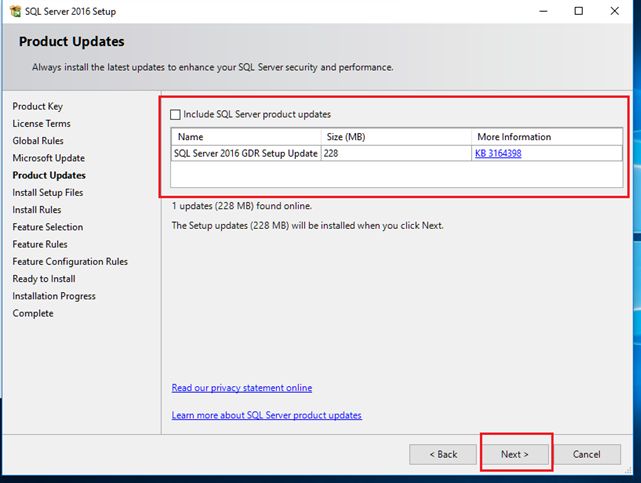
Check all the rules which are passed. Firewall gives a warning, which is not a problem, and you are good to go.
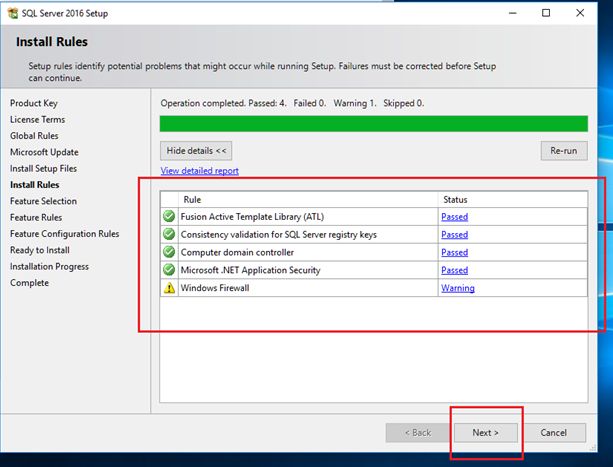
Select the required features and click next.
Part (1/2)
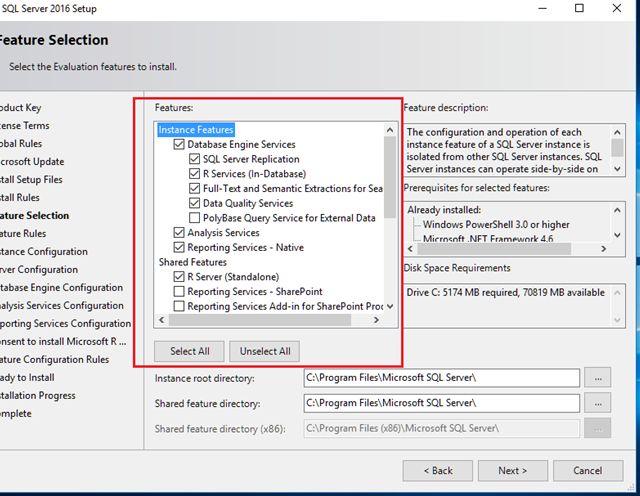
Part(2/2)
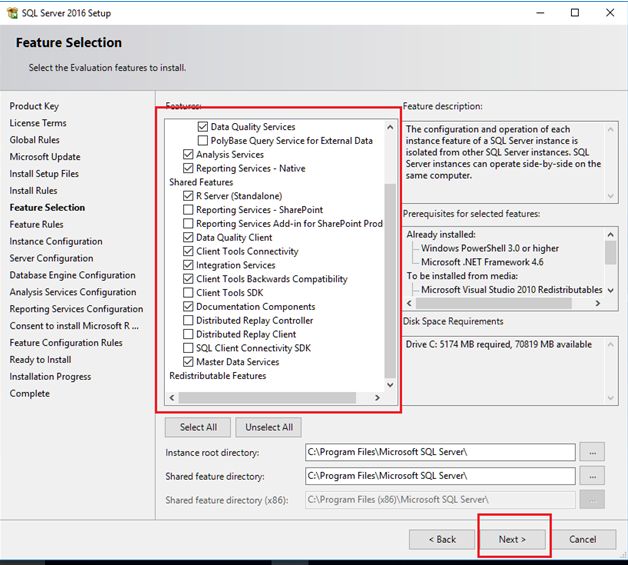
Click next to continue the installation.
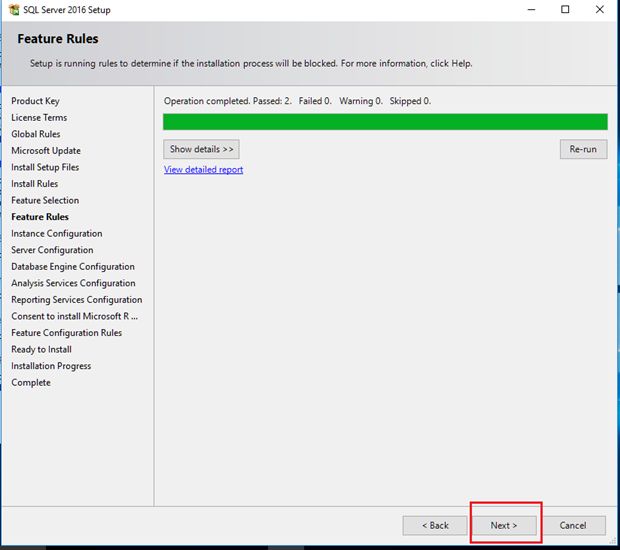
I am installing SQL Server on my machine first, so there will be no instance. Create a named instance, shown below, and click next.
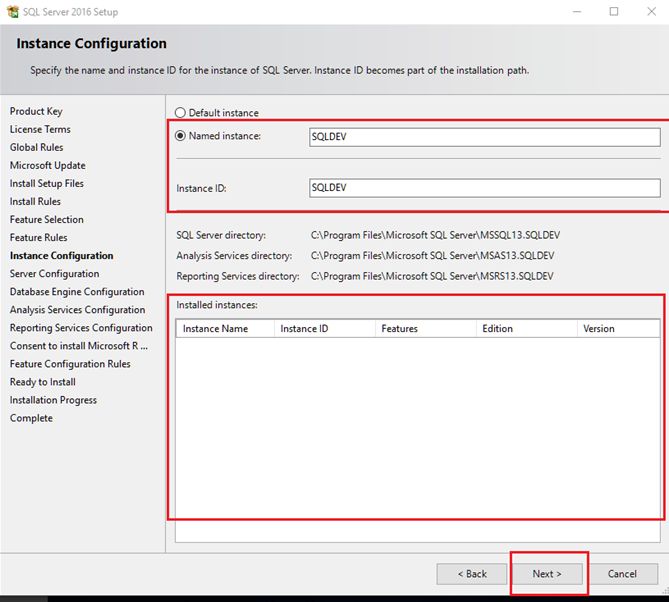
If you want a separate account to maintain SQL Server Service, you can create a new user profile and assign the password. Now I don’t need this, so I set the default one and click next.
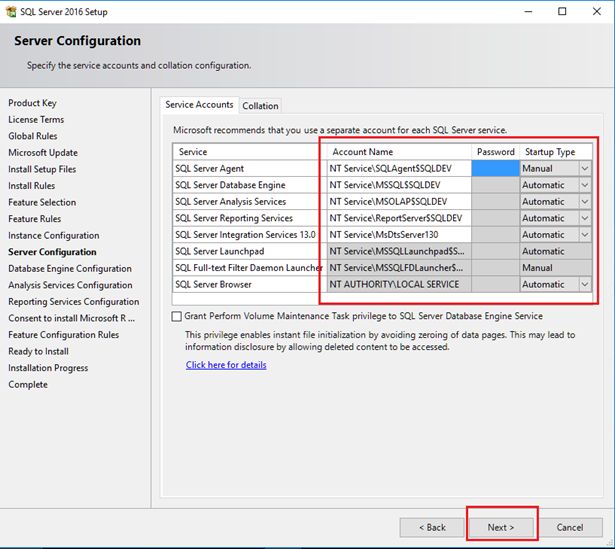
Select the mixed SQL Server Authentication to provide the password for SQL Server authentication. Click the ADD current user button to add the current user as an administrator.
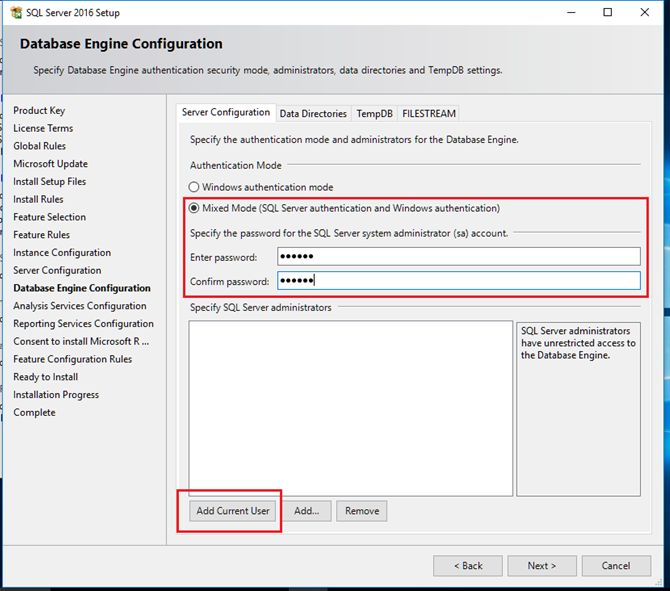
Once user is added click next.
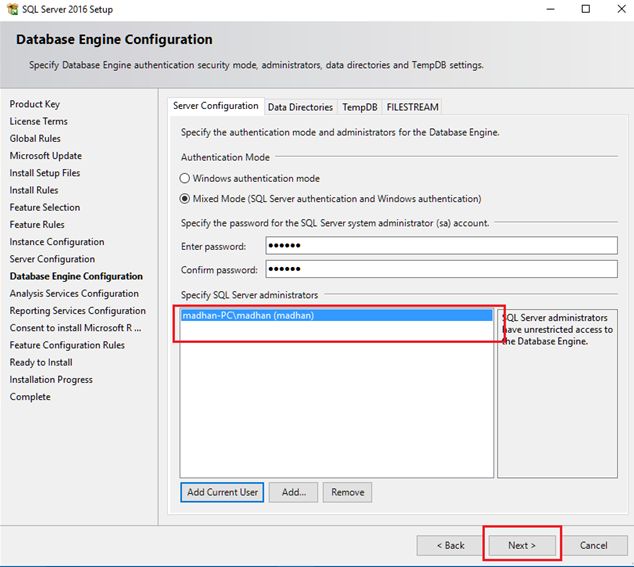
If you want, you can change the data directories path.
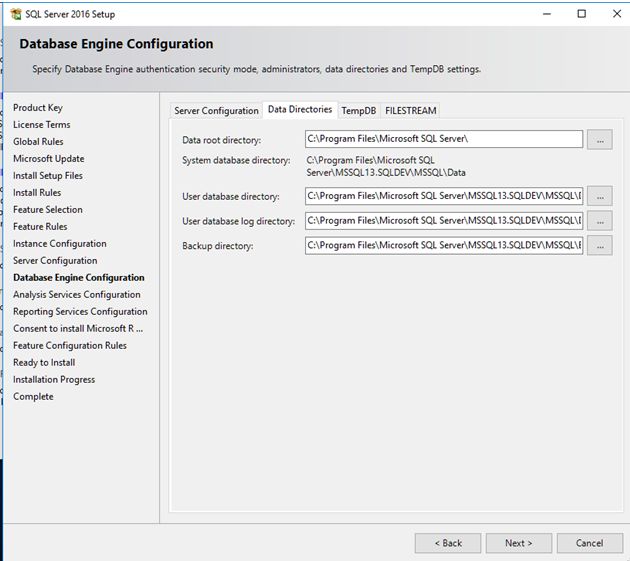
Check the Temp DB Size. If you want, you can change the temp DB size and the path.
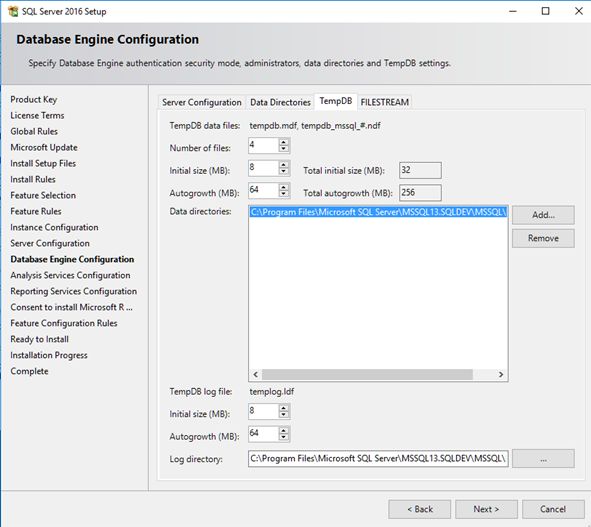
Enable the File stream. If required for more information about enabling and configuring File Stream, please click here. Click next.

Select SSAS Server Mode and add current user for SSAS administrator and click next.

Check the Analysis Service installation path. If you want, you can change the installation path and click next.
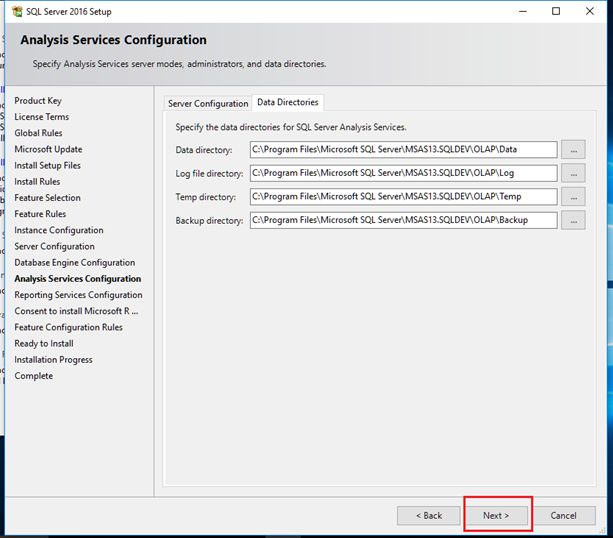
Select Install and Configure for SQL Server Native Mode.

Click Accept to install on your machine.

Click next to continue installation.

Check the features you are going to install and click install button.

It will take some time for the installation and click next, once installation completes.
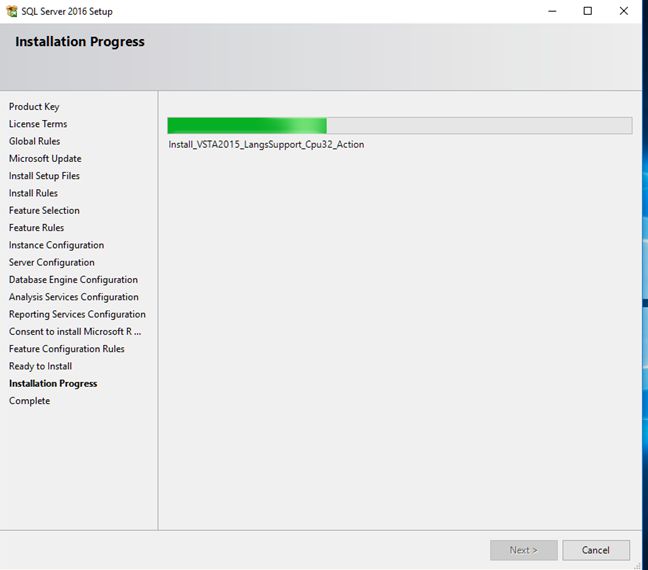
All the features are installed successfully.
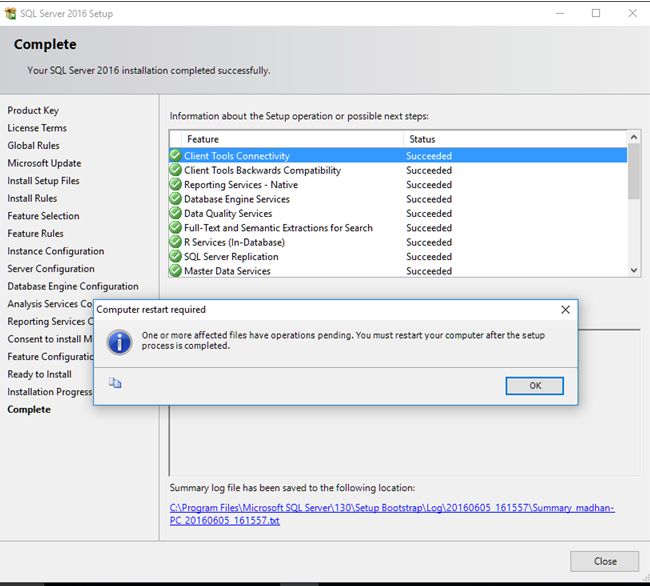
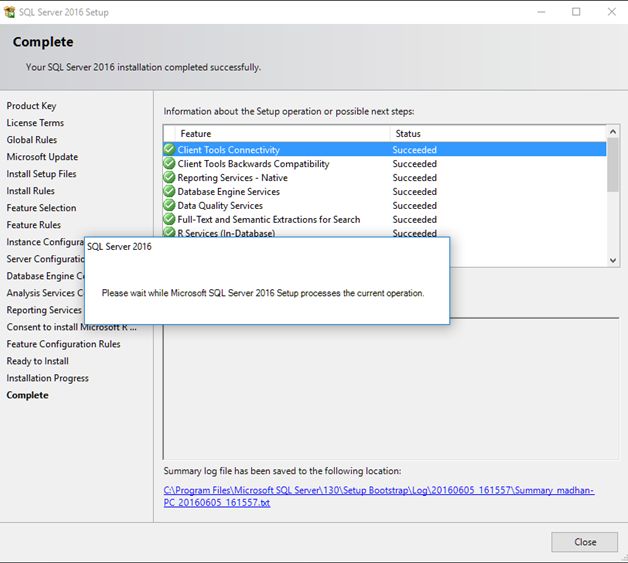
Click close to complete the installation.
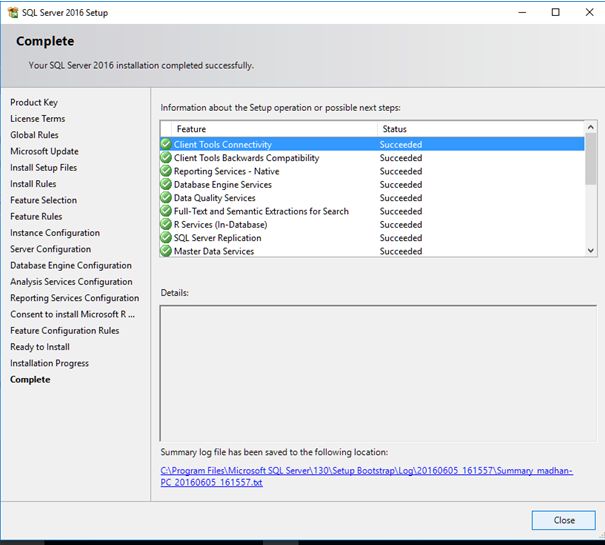
–SQL Server 2016 Enterprise edition is the premium editions of all in SQL Server 2016. This edition has all the features of SQL Server 2016.
SQL Server 2016 Enterprise edition delivers comprehensive high-end data center capabilities with blazing-fast performance, unlimited virtualization and end-to-end business intelligence — enabling high service levels for mission-critical workloads and end user access to data insights.
SQL Server 2016 Enterprise edition makes leading innovation available to any public cloud like AWS marketplace and Google Cloud Platform ( GCP ).
Cognosys provides hardened images of SQL Server 2016 Enterprise edition on all public cloud ( AWS marketplace and Google Cloud Platform).Also we offer other editions of SQL server 2016 such as SQL Server 2016 Web edition, SQL Server 2016 Standard edition and SQL Server 2016 Express edition.
SQL Server 2016 Enterprise Edition on Windows 2012 R2
SQL Server 2016 Enterprise Edition on Cloud for AWS
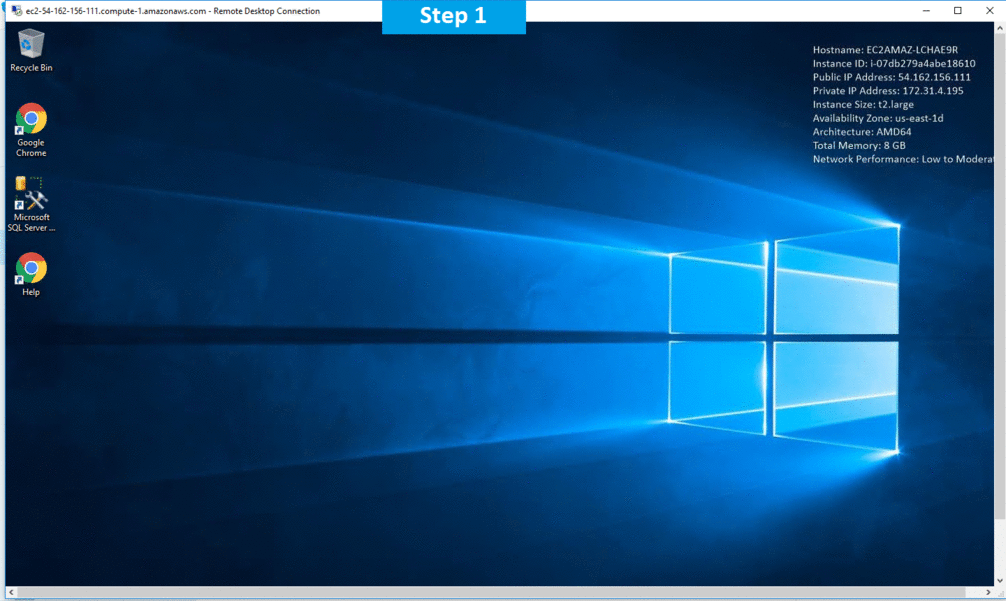
Features
Features of SQL Server:
- Always Encrypted
The Always Encrypted feature protects data and enables the SQL Server to perform encrypted data operations so that the owners can protect their confidential data by using an encryption key. This feature ensures that your important data stored in the cloud managed database remains encrypted and protected.
- Dynamic Data Masking
This feature gives an obscured version of your confidential data to some people and allows only authorized users to view it by defining masking rules. It is popularly used for managing credit card information and similar databases.
- Stretch Database
The Stretch Database permits you to extend your database to Azure where the data that is not accessed regularly are moved to the cloud so that you can enjoy high-performance applications while benefiting from the low-cost Azure store as only the frequently accessed data stays on premise.
- Real-time Operational Analytics
The real-time Operational Analytics of SQL 2016 prepare your system for optimal transactional performance and helps to increase workload consistency by combining in-memory OLTP with in-memory column store.
- Polybase
This feature works as a connector between SQL Server and Hadoop so that your regular data processing involving large text files can be stored conveniently in Azure Blob Storage or Hadoop. This technology bridges the gap between SQL Server and Hadoop to make data storage easy.
- Query Store
The Query Store feature of SQL 2016 version deals with the problem faced by previous servers in tracing the history of your execution plans as they only showed plans that are active in the plan cache. However, the inclusion of this feature in SQL Server 2016 allows you to track previous execution plans and performance by tracing your queries over a long period of time.
- Row Level Security
The Row Level Security feature is a major development in this database management system as it restricts some users to view data in tables by using an SQL Server login. It allows you to implement row level security so that new users will not be able to detect whether the rows of data were filtered for restricting data.
- Enhancements to AlwaysOn
The SQL 2016 version improves the ability of the AlwaysOn feature to have around three synchronous replicas in order to support availability and disaster recovery functions. It also relies on Distributed Transaction Coordinator support for load balancing and manages automatic failover.
- Revamped SQL Server Data Tools
The Revamped SQL Server Data Tools re-consolidate the data tools that had to be downloaded separately in the earlier versions as SQL Server 2016 presents a compact package to assist easy working on this database management system.
- JSON Support
The Java Script Object Notation feature allows you to interchange JSON data between the SQL Server database engine and various other applications. The SQL 2016 can analyze JSON formatted data and even convert relational data into JSON format for convenient storage.
Few more features of SQL Enterprise:
Performance Features of Microsoft SQL Enterprise
The Standard edition only has three of the eleven features in scalability and performance included in the Enterprise edition. Enterprise is the edition of choice if a company plans to scale in the near future. Generally, Enterprise supports up to 524 petabytes, but it can also support the maximum amount of RAM and number of core processors that the host system offers, compared to the Standard’s 128 GB.
Security Features of Microsoft SQL Enterprise
Another key component of Microsoft SQL Server Enterprise is security. Like the Standard edition, Enterprise includes basic auditing, contained databases, encryption and backups, and user-defined roles. It surpasses the Standard edition with its inclusion of fine grained auditing, transparent database encryption, and extensible key management. These are key tools to ensure maximum security.
Replication Features of Microsoft SQL Enterprise
In discussing the feature of replication, the Standard edition has most of the features including SQL Server change tracking, merge replication, and snapshot replication. Microsoft SQL Enterprise outperforms the Standard edition in Oracle publishing and peer-to-peer transaction replication.
———————————————————————————————————————————————————
Major Features of SQL Server 2016 Enterprise Edition
- Simplify big data : Take advantage of non-relational data with PolyBase technology built in that allows you to query structured and unstructured data with the simplicity of T-SQL.
- Mission critical intelligent applications : Deliver real-time operational intelligence by combining built-in advanced analytic and in-memory technology without having to move the data or impact end user performance.
- Highest performing data warehouse : Scale to petabytes of data for enterprise-grade relational data warehousing—and integrate with non-relational sources like Hadoop—using scale out, massively parallel processing from Microsoft Analytic Platform System. Support small data marts to large enterprise data warehouses while reducing storage needs with enhanced data compression.
- Mobile BI : Empower business users across the organization with the right insights on any mobile device.
- Easy to use tools : Use the skills you already have, along with familiar tools like Azure Active Directory and SQL Server Management Studio, to manage your database infrastructure across on-premises SQL Server and Microsoft Azure. Apply industry-standard APIs across various platforms and download updated developer tools from Visual Studio to build next-generation web, enterprise, business intelligence and mobile applications.
AWS
Installation Instructions For Windows
Installation Instructions for Windows
Step 1) RDP Connection: To connect to the deployed instance, Please follow Instructions to Connect to Windows instance on AWS Cloud
1) Connect to the virtual machine using following RDP credentials:
- Hostname: PublicDNS / IP of machine
- Port : 3389
Username: To connect to the operating system, use RDP and the username is Administrator.
Password: Please Click here to know how to get password
Step 2) SQL Connection: To Connect Microsoft SQL Server Management Studio in Windows server, Please follow Instructions to Connect Microsoft SQL Server Management Studio
Step 3) Database Credentials: You can Login by below SQL Database credentials
SQL UserName : sa || Password : Passw@rd123
Note: You can reset ‘sa’ password by using windows authentication to connect to local SQL instance. Please use localhost in the server name when connecting from inside the RDC
Step 4) Other Information:
1.Default ports:
- Windows Machines: RDP Port – 3389
- Http: 80
- Https: 443
- SQL Server Port: 1433 this is by default not allowed on the firewall for security.
Configure custom inbound and outbound rules using this link
Installation Step by Step Screenshots
Installation Instructions For Windows
Installation Instructions for Windows
Step 1) VM Creation:
- Click the Launch on Compute Engine button to choose the hardware and network settings.
2.You can see at this page, an overview of Cognosys Image as well as estimated cost of running the instance.
3.In the settings page, you can choose the number of CPUs and amount of RAM, the disk size and type etc.
Step 2) RDP Connection: To connect to the deployed instance, Please follow Instructions to Connect to Windows instance on Google Cloud
Step 3) SQL Connection: To Connect Microsoft SQL Server Management Studio in windows server, Please follow Instructions to Connect Microsoft SQL Server Management Studio
Step 4) Database Credentials:
You can Login by below SQL Database credentials
SQL UserName : sa
The below screen appears after successful deployment of the image.
i) Please connect to Remote Desktop as given in step 2
ii) You can use SQL server instance as localhost. The SQL Server instance name to be used is “localhost” Connect to SQL Management Studio with username as sa and password provided in Custom Metadata.
Step 5) Other Information:
1.Default ports:
- Windows Machines: RDP Port – 3389
- sql server port :1433: By default, this is blocked on Public interface for security reasons.
Configure custom inbound and outbound rules using this link
Videos
SQL Server 2016 Enterprise Edition on Windows 2012 R2
How to Create Database in SQL Server 2016

